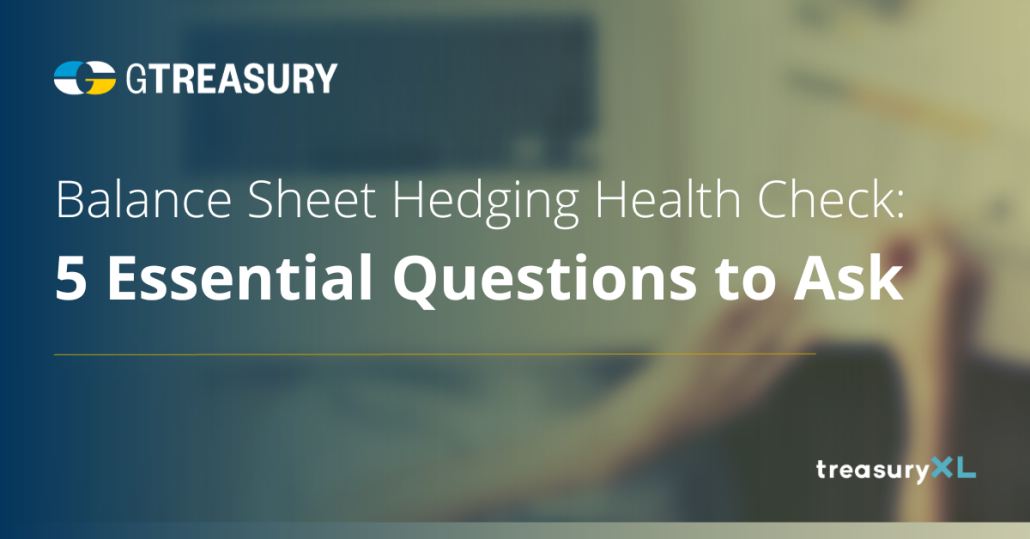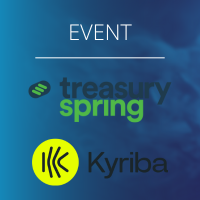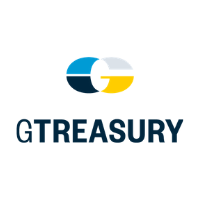Balance Sheet Hedging Health Check: 5 Essential Questions to Ask
By GTreasury
Is your balance sheet hedge program doing its job? Sometimes, balance sheet hedging has hidden weaknesses and nuances that, when not periodically reviewed, can cause even more risk. Here are five questions you can ask to ensure your program is running well.

Balance sheet risk – also known as transaction accounting risk – is the most commonly hedged currency risk, resulting from monetary transactions recorded on the balance sheet in a currency other than an entity’s functional currency. Balance sheet hedging mitigates foreign currency gains and losses caused by the difference in currency rates. The hedge essentially neutralizes the P&L.
This type of hedging is common, but so are certain weaknesses that can slip through the cracks and create more risk or ineffective hedge results. Sometimes, companies mitigate certain aspects of currency risk while creating others. Other times, hidden aspects of a hedge program can cause problems.
There can be certain signs that a balance sheet hedge program is not what it seems. Here are five questions you should be asking about your balance sheet hedging to see how well it’s performing.
1. Are you delivering regularly on your hedge contracts?
2. Are you converting cash at the hedge rate?
3. Are you hedging away local currency?
4. Can you explain away residual foreign currency gains & losses?
5. Are your inter-company hedges uneconomic?
Find out why these questions are important.
Can’t get enough? Check out these latest items
 https://treasuryxl.com/wp-content/uploads/2025/11/FinanceKey-Featured.png
200
200
treasuryXL
https://treasuryxl.com/wp-content/uploads/2018/07/treasuryXL-logo-300x56.png
treasuryXL2025-11-28 12:48:162025-11-28 14:28:40Five real-time treasury myths (and what we’re really seeing)
https://treasuryxl.com/wp-content/uploads/2025/11/FinanceKey-Featured.png
200
200
treasuryXL
https://treasuryxl.com/wp-content/uploads/2018/07/treasuryXL-logo-300x56.png
treasuryXL2025-11-28 12:48:162025-11-28 14:28:40Five real-time treasury myths (and what we’re really seeing) https://treasuryxl.com/wp-content/uploads/2024/01/Template_VACANCY-featured.png
200
200
treasuryXL
https://treasuryxl.com/wp-content/uploads/2018/07/treasuryXL-logo-300x56.png
treasuryXL2025-11-28 07:00:442025-11-27 14:57:08Interesting Vacancies in Germany!
https://treasuryxl.com/wp-content/uploads/2024/01/Template_VACANCY-featured.png
200
200
treasuryXL
https://treasuryxl.com/wp-content/uploads/2018/07/treasuryXL-logo-300x56.png
treasuryXL2025-11-28 07:00:442025-11-27 14:57:08Interesting Vacancies in Germany! https://treasuryxl.com/wp-content/uploads/2025/11/TreasurySpring-van-Template-1.png
200
200
treasuryXL
https://treasuryxl.com/wp-content/uploads/2018/07/treasuryXL-logo-300x56.png
treasuryXL2025-11-27 15:43:202025-11-27 15:44:57Treasury as a Value Creator – From Back Office to Boardroom
https://treasuryxl.com/wp-content/uploads/2025/11/TreasurySpring-van-Template-1.png
200
200
treasuryXL
https://treasuryxl.com/wp-content/uploads/2018/07/treasuryXL-logo-300x56.png
treasuryXL2025-11-27 15:43:202025-11-27 15:44:57Treasury as a Value Creator – From Back Office to Boardroom https://treasuryxl.com/wp-content/uploads/2025/11/Enza.png
200
200
treasuryXL
https://treasuryxl.com/wp-content/uploads/2018/07/treasuryXL-logo-300x56.png
treasuryXL2025-11-27 10:12:192025-11-27 10:12:52Stage Finance | Treasury @ Enza Zaden
https://treasuryxl.com/wp-content/uploads/2025/11/Enza.png
200
200
treasuryXL
https://treasuryxl.com/wp-content/uploads/2018/07/treasuryXL-logo-300x56.png
treasuryXL2025-11-27 10:12:192025-11-27 10:12:52Stage Finance | Treasury @ Enza Zaden https://treasuryxl.com/wp-content/uploads/2025/11/Aastha-blog.png
200
200
treasuryXL
https://treasuryxl.com/wp-content/uploads/2018/07/treasuryXL-logo-300x56.png
treasuryXL2025-11-27 07:00:432025-11-26 09:39:58Africa’s Critical Minerals Boom and What It Means for Treasury
https://treasuryxl.com/wp-content/uploads/2025/11/Aastha-blog.png
200
200
treasuryXL
https://treasuryxl.com/wp-content/uploads/2018/07/treasuryXL-logo-300x56.png
treasuryXL2025-11-27 07:00:432025-11-26 09:39:58Africa’s Critical Minerals Boom and What It Means for Treasury https://treasuryxl.com/wp-content/uploads/2025/06/Konstantin-Template_BLOGS-Expert-featured-1.png
200
200
treasuryXL
https://treasuryxl.com/wp-content/uploads/2018/07/treasuryXL-logo-300x56.png
treasuryXL2025-11-26 07:00:052025-11-25 16:07:19ISO 20022: Benefits, Challenges and How To of Migration
https://treasuryxl.com/wp-content/uploads/2025/06/Konstantin-Template_BLOGS-Expert-featured-1.png
200
200
treasuryXL
https://treasuryxl.com/wp-content/uploads/2018/07/treasuryXL-logo-300x56.png
treasuryXL2025-11-26 07:00:052025-11-25 16:07:19ISO 20022: Benefits, Challenges and How To of Migration https://treasuryxl.com/wp-content/uploads/2025/11/Featured_ETR_Digital-2.png
200
200
treasuryXL
https://treasuryxl.com/wp-content/uploads/2018/07/treasuryXL-logo-300x56.png
treasuryXL2025-11-25 11:44:332025-11-25 11:44:33ETR Digital Takes Home the Working Capital Innovation Award
https://treasuryxl.com/wp-content/uploads/2025/11/Featured_ETR_Digital-2.png
200
200
treasuryXL
https://treasuryxl.com/wp-content/uploads/2018/07/treasuryXL-logo-300x56.png
treasuryXL2025-11-25 11:44:332025-11-25 11:44:33ETR Digital Takes Home the Working Capital Innovation Award https://treasuryxl.com/wp-content/uploads/2025/10/Kurt-Expert-featured.png
200
200
treasuryXL
https://treasuryxl.com/wp-content/uploads/2018/07/treasuryXL-logo-300x56.png
treasuryXL2025-11-25 07:00:152025-11-24 15:35:04How to Create Lasting Enterprise Value
https://treasuryxl.com/wp-content/uploads/2025/10/Kurt-Expert-featured.png
200
200
treasuryXL
https://treasuryxl.com/wp-content/uploads/2018/07/treasuryXL-logo-300x56.png
treasuryXL2025-11-25 07:00:152025-11-24 15:35:04How to Create Lasting Enterprise Value https://treasuryxl.com/wp-content/uploads/2025/05/Francois-Template_BLOGS-Expert-featured-7.png
200
200
treasuryXL
https://treasuryxl.com/wp-content/uploads/2018/07/treasuryXL-logo-300x56.png
treasuryXL2025-11-24 08:30:272025-11-24 08:32:52Roundtable on Alternative Methods of Funding
https://treasuryxl.com/wp-content/uploads/2025/05/Francois-Template_BLOGS-Expert-featured-7.png
200
200
treasuryXL
https://treasuryxl.com/wp-content/uploads/2018/07/treasuryXL-logo-300x56.png
treasuryXL2025-11-24 08:30:272025-11-24 08:32:52Roundtable on Alternative Methods of Funding


